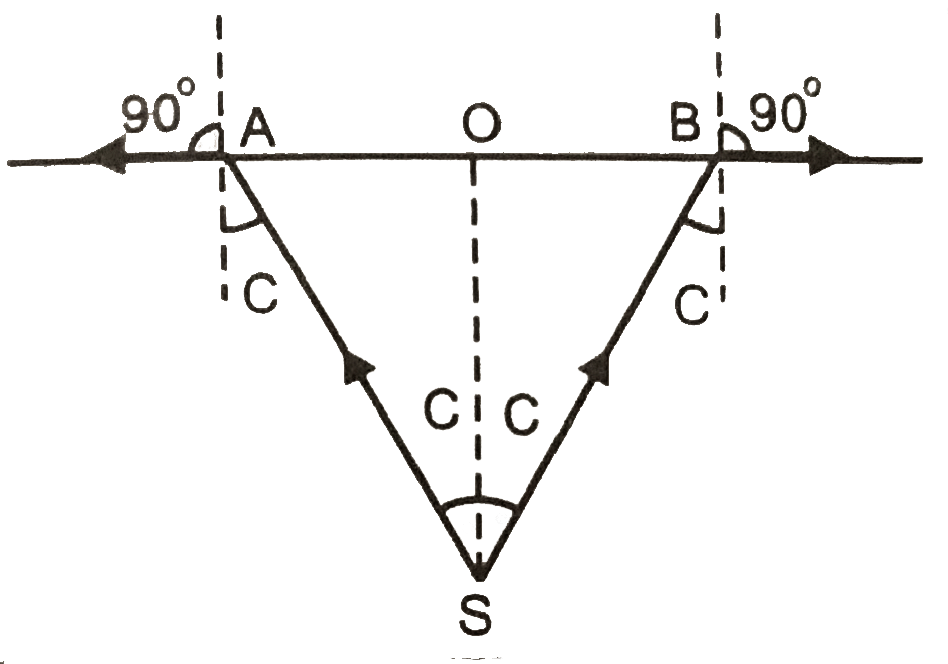A small bulb is placed at the bottom of a tank containing water to a depth of 80cm. What is the area of the surface of water through which light from the bulb can emerge? The refractive index of water is 1.33. (Consider the bulb to be a point source.)

A small bulb is placed at the bottom of a tank containing water to a depth of 80cm. What is the area of the surface of water through which light from the bulb can emerge? The refractive index of water is 1.33. (Consider the bulb to be a point source.)

Solution and Explanation
The actual depth of the bulb in water,d1=80cm=0.8m
Refractive index of water,μ=1.33
The given situation is shown in the following figure: Where i=Angle of incidence r=Angle of refraction=90º
Since the bulb is a point source, the emergent light can be considered as a circle of radius, R=\(\frac{AC}{2}\)AO=OB
Using Snell law, we can write the relation for the refractive index of water as:μ=\(\frac{sin\,r}{sin\,i}\)=1.33=\(\frac{sin90^{\circ}}{sin\,i}\)
∴i=sin-1(\(\frac{1}{3.33}\))=48.75º
Using the given figure, we have the relation:tani=\(\frac{OC}{OB}\)=\(\frac{R}{d_1}\)
R=tan48.75º×0.8=0.91m
Area of the structure of water\(\pi R^2\)=\(\pi\)(0.91)2=2.61m2
Hence, the area of the structure of water through which the light from the bulb can emerge is approximately 2.61m2.
Top Questions on Ray optics and optical instruments
- Explain the transmission of optical signal through an optical fiber with a diagram.
- CBSE CLASS XII - 2025
- Physics
- Ray optics and optical instruments
- A point source of light in air is kept at a distance of 12 cm in front of a convex spherical surface of glass of refractive index 1.5 and radius of curvature 30 cm. Find the nature and position of the image formed.
- CBSE CLASS XII - 2025
- Physics
- Ray optics and optical instruments
- A thin prism \( P_1 \) with angle \( 4^\circ \) made of glass having refractive index 1.54 is combined with another thin prism \( P_2 \) made of glass having refractive index 1.72 to get dispersion without deviation. The angle of the prism \( P_2 \) in degrees is:
- JEE Main - 2025
- Physics
- Ray optics and optical instruments
A hemispherical vessel is completely filled with a liquid of refractive index \( \mu \). A small coin is kept at the lowest point \( O \) of the vessel as shown in the figure. The minimum value of the refractive index of the liquid so that a person can see the coin from point \( E \) (at the level of the vessel) is:

- JEE Main - 2025
- Physics
- Ray optics and optical instruments
- If \( \lambda \) and \( K \) are de Broglie wavelength and kinetic energy, respectively, of a particle with constant mass. The correct graphical representation for the particle will be:
- JEE Main - 2025
- Physics
- Ray optics and optical instruments
Questions Asked in CBSE CLASS XII exam
- The principal value of \( \cot^{-1} \left( -\frac{1}{\sqrt{3}} \right) \) is:
- CBSE CLASS XII - 2025
- Inverse Trigonometric Functions
- Why does M. Hamel refer to language as a key to freedom from slavery? (The Last Lesson)
- CBSE CLASS XII - 2025
- The Last Lesson
- Bama and Zitkala-Sa have proven that education is the antidote to all social evils. Analyse their characters in terms of their struggles and their will to win. (Memories of Childhood)
- CBSE CLASS XII - 2025
- Literature
“One of these days you’re going to talk yourself into a load of trouble,” her father said aggressively. What do you learn about Sophie’s father from these lines? (Going Places)
- CBSE CLASS XII - 2025
- Literature
- (b) In a village of 8000 people, 3000 go out of the village to work and 4000 are women. It is noted that 30% of women go out of the village to work. What is the probability that a randomly chosen individual is either a woman or a person working outside the village?
- CBSE CLASS XII - 2025
- Probability
Concepts Used:
Ray Optics and Optical Instruments
Optics, deals with the determination of behaviour and the properties of light, along with its interactions with the matter and also with the instruments that are used to detect it.
Ray optics is also known as the geometrical optics and it is a branch of science which describes light propagation.
Reflection is the change in direction of light at an interface in-between two different media so that the wave-front returns into a medium from which it was originated.
Speed of light is the rate at which the light travels in free space.
A phenomenal change in image formed when the light is passed from one medium to another which is called Refraction.
Total Internal Reflection is the reflection of light when the light ray enters into a rarer medium from a denser medium and the angle of incidence is higher than the critical angle of incidence then that light ray will be reflected back to the denser medium.
Read More: Ray Optics and Optical Instruments